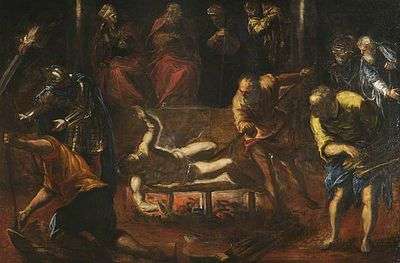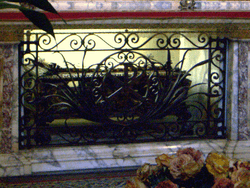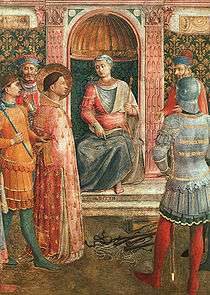Lawrence of Rome
| Saint Lawrence | |
|---|---|
|
Lawrence before Valerianus, detail from a fresco by Fra Angelico, c. 1447–1450, Pinacoteca Vaticana | |
| Martyr | |
| Born |
c. 225 AD Osca, Hispania (now modern-day Spain) |
| Died |
258 AD 10 August Rome |
| Venerated in |
Catholic Church Eastern Orthodoxy Anglican Communion Lutheranism |
| Canonized | Pre-Congregation |
| Major shrine | Basilica di San Lorenzo fuori le Mura in Rome |
| Feast | 10 August |
| Attributes | Usually holding a gridiron and wearing a dalmatic |
| Patronage | Rome, Rotterdam (Netherlands), Huesca (Spain), San Lawrenz, Gozo and Birgu (Malta), Barangay San Lorenzo San Pablo (Philippines), Canada, Sri Lanka, comedians, librarians, students, miners, tanners, chefs, roasters, poor, firefighters |
Lawrence or Laurence of Rome (Latin: Laurentius, lit. "laurelled"; c. 225–258) was one of the seven deacons of the city of Rome under Pope Sixtus II who were martyred during the persecution by Emperor Valerian in 258.
Life of Saint Lawrence
St Lawrence is thought to have been born in Huesca, a town in the region of Aragon that was once part of the Roman province of Hispania Tarraconensis. The martyrs Orentius and Patientia are traditionally held to have been his parents.[1]
He encountered the future Pope Sixtus II, who was of Greek origin, one of the most famous and highly esteemed teachers in Caesaraugusta (today Zaragoza). Eventually, both left Spain for Rome. When Sixtus became the Pope in 257, he ordained St Lawrence as a deacon, and though Lawrence was still young appointed him first among the seven deacons who served in the patriarchal church. He is therefore called "archdeacon of Rome", a position of great trust that included the care of the treasury and riches of the church and the distribution of alms among the poor.[2]
St Cyprian, Bishop of Carthage, notes that Roman authorities had established a norm according to which all Christians who had been denounced must be executed and their goods confiscated by the Imperial treasury. At the beginning of August 258, the Emperor Valerian issued an edict that all bishops, priests, and deacons should immediately be put to death. Sixtus was captured on 6 August 258, at the cemetery of St Callixtus while celebrating the liturgy and executed forthwith.[3]
After the death of Sixtus, the prefect of Rome demanded that St Lawrence turn over the riches of the Church. Saint Ambrose is the earliest source for the tale that St Lawrence asked for three days to gather together the wealth.[4] He worked swiftly to distribute as much Church property to the poor as possible, so as to prevent its being seized by the prefect. On the third day, at the head of a small delegation, he presented himself to the prefect, and when ordered to give up the treasures of the Church he presented the poor, the crippled, the blind and the suffering, and said these were the true treasures of the Church.[5] One account records him declaring to the prefect, "The Church is truly rich, far richer than your emperor." This act of defiance led directly to his martyrdom and can be compared to the parallel Roman tale of the jewels of Cornelia.
On 10 August, St Lawrence, the last of the seven deacons, suffered a martyr's death.[6]
Martyrdom

By tradition, St Lawrence was sentenced at San Lorenzo in Miranda, imprisoned in San Lorenzo in Fonte, and martyred at San Lorenzo in Panisperna. The Almanac of Philocalus for the year 354 mentions that he was buried in the Via Tiburtina in the Catacomb of Cyriaca[6] by Hippolytus and Justin the Confessor, a presbyter. One of the early sources for the martyrdom was the description by Aurelius Prudentius Clemens in his Peristephanon, Hymn II.
A well-known legend has persisted from earliest times. As deacon in Rome, St Lawrence was charged with the responsibility for the material goods of the Church and the distribution of alms to the poor.[5] St Ambrose of Milan relates that when St Lawrence was asked for the treasures of the Church he brought forward the poor, among whom he had divided the treasure as alms.[6] "Behold in these poor persons the treasures which I promised to show you; to which I will add pearls and precious stones, those widows and consecrated virgins, which are the church's crown."[2] The prefect was so angry that he had a great gridiron prepared, with coals beneath it, and had Lawrence's body placed on it (hence St Lawrence's association with the gridiron). After the martyr had suffered the pain for a long time, the legend concludes, he made his famous cheerful remark, "I'm well done. Turn me over!"[5][7] From this derives his patronage of cooks, chefs, and comedians.
Some historians, such as Rev. Patrick Healy, view the traditions of how St Lawrence was martyred as "not worthy of credence",[8] as the slow lingering death cannot be reconciled "with the express command contained in the edict regarding bishops, priests, and deacons (animadvertantur) which ordinarily meant decapitation."[8] A theory of how the tradition arose is put forward by Pio Franchi de' Cavalieri, who postulates that it was the result of a mistaken transcription, the accidental omission of the letter "p" – "by which the customary and solemn formula for announcing the death of a martyr – passus est ["he suffered," that is, was martyred] – was made to read assus est [he was roasted]."[8] The Liber Pontificalis, which is held to draw from sources independent of the existing traditions and Acta regarding Lawrence, uses passus est concerning him, the same term it uses for Pope Sixtus II (martyred by beheading during the same persecution).[8]
Constantine I is said to have built a small oratory in honour of St Lawrence, which was a station on the itineraries of the graves of the Roman martyrs by the seventh century. Pope Damasus I rebuilt or repaired the church, now San Lorenzo fuori le Mura, while the minor basilica of San Lorenzo in Panisperna was built over the place of his martyrdom. The gridiron of the martyrdom was placed by Pope Paschal II in the church of San Lorenzo in Lucina.
Miracles
The life and miracles of St Lawrence were collected in The Acts of St Lawrence but those writings have been lost. The earliest existing documentation of miracles associated with him is in the writings of St Gregory of Tours (538–594), who mentions the following:
A priest named Fr. Sanctulus was rebuilding a church of St Lawrence, which had been attacked and burnt, and hired many workmen to accomplish the job. At one point during the construction, he found himself with nothing to feed them. He prayed to St Lawrence for help, and looking in his basket he found a fresh, white loaf of bread. It seemed to him too small to feed the workmen, but in faith he began to serve it to the men. While he broke the bread, it so multiplied that that his workmen fed from it for ten days.[2]
Veneration

Due to his conspiring to hide and protect the written documents of the Church, St Lawrence is known as the patron saint of archivists and librarians.[9]
Roman Catholic Church
St Lawrence is one of the most widely venerated saints of the Roman Catholic Church. Legendary details of his death were known to Damasus, Prudentius, Ambrose and Augustine. The church built over his tomb, San Lorenzo fuori le Mura, became one of the seven principal churches in Rome and a favorite place for Roman pilgrimages.[7] Devotion to him was widespread by the fourth century. Since the Perseid Meteor Shower typically occurs every year in mid-August on or near his feast day, some refer to the shower as the "Tears of St Lawrence".[2]

St Lawrence is especially honoured in the city of Rome, where he is one of the city's patrons. There are several churches in Rome dedicated to him, including San Lorenzo in Panisperna, traditionally identified as the place of his execution; the area near the San Lorenzo basilica is called Quartiere San Lorenzo. He is invoked by librarians, archivists, cooks, and tanners as their patron. His celebration on 10 August has the rank of feast throughout the Catholic world.[10] On this day, the reliquary containing his burnt head is displayed in the Vatican for veneration.
St Lawrence is the patron saint of Ampleforth Abbey whose Benedictine monks founded one of the world's leading public schools for Catholics, located in North Yorkshire (North East England).
Anglican Communion
Within Anglicanism the saint's name is traditionally spelt Laurence. His feast appears (on 10 August) in the calendar of the Book of Common Prayer, the volume of prayers which, in its 1662 format, was the founding liturgical document of a majority of Anglican Provinces. In the Book of Common Prayer the feast is entitled "S Laurence, Archdeacon of Rome and Martyr". The celebration of his feast, on 10 August, has carried into the contemporary calendars of most Anglican Provinces,[11] including the Church of England,[12] which designates it a lesser festival, under the title "Laurence, deacon, martyr, 258".
Laurence is venerated by Anglo-Catholics, and is the patron of many Anglican parish churches, including more than 200 in England.[13][14] A major church in Sydney, Australia, in the former civil (land division) parish of St Laurence, known as "Christ Church St Laurence". The Brotherhood of St Laurence, an Anglican-foundation charitable society, also bears his name.
Legacy
According to Fr Francesco Moraglia, Professor of Dogmatic Theology, the role of deacon is distinguished by service of the poor. He is destined both to the service of the table (corporal works of mercy) and to the service of the word (spiritual works of mercy). "The beauty, power and the heroism of Deacons such as Lawrence help to discover and come to a deeper meaning of the special nature of the diaconal ministry."[3]
In Freemasonry the Order of St Lawrence the Martyr is a masonic degree whose ritual is based upon the story of the martyr. It is one of the constituent degrees of the Allied Masonic Degrees.
A practically innumerable host of churches, schools, parishes, towns and geographic features all over the world have been named after Lawrence of Rome the deacon and martyr over the centuries. Depending on locality they can be named St Lawrence, St Laurence, San Lorenzo, St Laurent, St Lorenz or similarly in other languages.
One example is San Lorenzo del Escorial, the monastery built by Philip II of Spain to commemorate his victory at Saint-Quentin on the feast day of St Lawrence. The monastery and the attached palace, college, and library are laid out in a grid resembling a grill with a handle.
On his second voyage, French explorer Jacques Cartier, arriving in the widest river estuary in the world on St. Lawrence's feast day of 1535, named it the Gulf of St. Lawrence.[15] The river emptying into this the gulf was correspondingly called the St Lawrence River. Many names in what are now Québec and the Maritime Provinces of Canada were given after this important seaway, like the Laurentian mountains (north of the city of Montreal), Saint-Laurent (borough), the famed Saint Lawrence Boulevard, which spans the width of the Island of Montreal, and St Lawrence County, New York, near Lake Ontario.
The rescue operation for the miners trapped in the 2010 Copiapó mining accident in Chile was termed Operación San Lorenzo after the saint.
Gallery
 A statue of St Lawrence overlooking the river named after him, the Saint Lawrence River
A statue of St Lawrence overlooking the river named after him, the Saint Lawrence River St Lawrence holding the gridiron, by the Master of Meßkirch, c.1535-40.
St Lawrence holding the gridiron, by the Master of Meßkirch, c.1535-40.- St Lawrence, Ranworth Rood Screen, Ranworth, St Helen's Church, UK, c.1430
 St Lawrence pictured on the astronomical clock in Lund Cathedral, Sweden.
St Lawrence pictured on the astronomical clock in Lund Cathedral, Sweden. St Lawrence depicted in a 14th-century book of hours
St Lawrence depicted in a 14th-century book of hours
In popular culture
In Fargo season 1, episode 3, Lorne Malvo notes the stained glass window of Saint Lawrence in Stavros' office, in response to which Stavros relates the martyrdom story saying that Lawrence was the patron saint of "hard asses", in "A Muddy Road".
See also
It should be noted that several other saints were also named "Lawrence" (or the corresponding local variant), so one might also occasionally encounter something named after one of them. More information on these topics can currently be accessed through disambiguation articles like:
Another list can be found at the category page Lawrence of Rome which is reserved for articles connected with this particular saint.
References
- ↑ Sts. Orentius and Patientia Catholic Online
- 1 2 3 4 ""St. Lawrence, Deacon Martyr," said to have been martyred by being put on a gridiron. St. Lawrence Orthodox Christian Church" (PDF).
- 1 2 "Moraglia, Fr. Francesco, "St. Lawrence, Proto-Deacon Of The Roman Church", Vatican".
- ↑ Saint Ambrose, De officiis ministrorum, 2.28
- 1 2 3 Fr. Paolo O. Pirlo, SHMI (1997). "St. Lawrence". My First Book of Saints. Sons of Holy Mary Immaculate – Quality Catholic Publications. pp. 176–178. ISBN 971-91595-4-5.
- 1 2 3 "Kirsch, Johann Peter. "St. Lawrence." The Catholic Encyclopedia. Vol. 9. New York: Robert Appleton Company, 1910. 9 February 2013".
- 1 2 Foley OFM, Leonard, "St. Lawrence", Saint of the Day, Lives, Lessons, and Feast (Revised by Pat McCloskey OFM), Franciscan Media ISBN 978-0-86716-887-7
- 1 2 3 4 Rev. Patrick Joseph Healy (1905). The Valerian persecution: a study of the relations between church and state in the third century A.D. Boston, Ma: Houghton, Mifflin, & Co.
- ↑ OWENS, B. (2003). The safeguarding of memory: The divine function of the librarian and archivist (English). Library & Archival Security, 18(1), 9–41
- ↑ From the oldest Christian calendars, such as the Almanac of Philocalus for the year 354, the inventory of which contains the principal feasts of the Roman martyrs of the middle of the fourth century, onwards.
- ↑ See, for example, "An Anglican Prayer Book" (1989), the Province of Southern Africa, published Collins Liturgical, ISBN 0 00 599180 3, Calendar page 24.
- ↑ See "Common Worship" (2000) core edition, published Church House Publishing, ISBN 0 7151 2000 X, Calendar page 12.
- ↑ The Oxford Dictionary of Saints, published Oxford University Press, ISBN 0 19 283069 4 (paperback), cites 228 churches.
- ↑ Church of England official index (ACNY) cites 224 combining Lawrence and Laurence spellings.
- ↑ Johnson, William Henry (20 May 2007). French Pathfinders in North America. Gutenberg.org. Retrieved 27 February 2011.
External links
| Wikimedia Commons has media related to Saint Lawrence. |
- Henry Wace, A Dictionary of Christian Biography: Laurentius
- Golden Legend: "The Life of Saint Laurence"
- Leo I: Sermon on St Lawrence
- Church of Saint Lawrence, Birgu, Malta
- Patron of Ampleforth Abbey, North Yorkshire
- Colonnade Statue in St Peter's Square
- CatholicSaints
- Santiebeati
- Vatican.va
